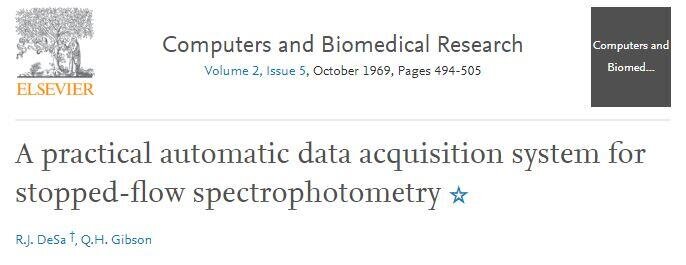The Ultimate Guide To Spectrophotometers
The Ultimate Guide To Spectrophotometers
Blog Article
Not known Incorrect Statements About Circular Dichroism
Table of ContentsThe Best Guide To Circular DichroismUv/vis Can Be Fun For AnyoneSome Of SpectrophotometersUv/vis/nir for BeginnersHow Circular Dichroism can Save You Time, Stress, and Money.

Spectrophotometry is a tool that hinges on the quantitative analysis of particles depending on how much light is taken in by colored compounds.
Circularly Polarized Luminescence Can Be Fun For Anyone
A spectrophotometer is commonly used for the measurement of transmittance or reflectance of solutions, transparent or opaque solids, such as sleek glass, or gases. Many biochemicals are colored, as in, they take in visible light and therefore can be measured by colorimetric treatments, even colorless biochemicals can frequently be transformed to colored substances appropriate for chromogenic color-forming reactions to yield compounds suitable for colorimetric analysis.: 65 However, they can likewise be designed to measure the diffusivity on any of the listed light varieties that generally cover around 2002500 nm utilizing various controls and calibrations.
An example of an experiment in which spectrophotometry is used is the determination of the equilibrium constant of an option. A specific chemical response within a service may occur in a forward and reverse direction, where reactants form items and items break down into reactants. At some point, this chemical reaction will reach a point of balance called a stability point.
A Biased View of Uv/vis/nir
The quantity of light that goes through the service is indicative of the concentration of particular chemicals that do not permit light to go through. The absorption of light is due to the interaction of light with the electronic and vibrational modes of particles. Each type of molecule has an individual set of energy levels related to the makeup of its chemical bonds and nuclei and thus will soak up light of particular wavelengths, or energies, leading to distinct spectral properties.
Making use of spectrophotometers covers numerous scientific fields, such as physics, materials science, chemistry, biochemistry. circular dichroism, chemical engineering, and molecular biology. They are widely used in numerous industries consisting of semiconductors, laser and optical production, printing and forensic assessment, in addition to in laboratories for the research study of chemical substances. Spectrophotometry is typically used in measurements of enzyme activities, decisions of protein concentrations, determinations of enzymatic kinetic constants, and measurements of ligand binding reactions.: 65 Eventually, a spectrophotometer is able to identify, depending on the control or calibration, what compounds exist in a target and precisely how much through calculations of observed wavelengths.
This would come as a solution to the previously developed spectrophotometers which were unable to take in the ultraviolet correctly.
The Circularly Polarized Luminescence Statements
It would be discovered that this did not provide acceptable results, for that reason in Model B, there was a shift from a glass to a quartz prism which enabled much better absorbance results - spectrophotometers (http://www.cartapacio.edu.ar/ojs/index.php/iyd/comment/view/1414/0/30215). From there, Design C was born with a change to the wavelength resolution which wound up having three units of it produced
It irradiates the sample with polychromatic light which the sample absorbs depending on its homes. It is transmitted back by grating the photodiode range which spots the wavelength region of the spectrum. Ever since, the production and execution of spectrophotometry devices has actually increased exceptionally and has actually turned into one of the most ingenious instruments of our time.

Get This Report on Uv/vis
The grating can either be movable or fixed.
In such systems, the grating is repaired and the strength of each wavelength of light is determined by a various detector in the array. When making transmission measurements, the spectrophotometer quantitatively compares the fraction of light that passes through a reference solution and a test service, then electronically compares the strengths of the 2 signals and calculates the percentage of transmission of the sample compared to the referral requirement.

Report this page